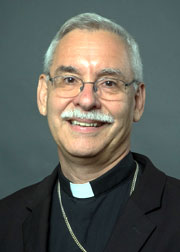Official Website of the
Catholic Diocese of Little Rock
Feast of the Santo Niño de Cebú
Published: January 15, 2023
Bishop Anthony B. Taylor preached the following homily at Blessed Sacrament Church in Jonesboro on Sunday, Jan. 15, 2023. It is based on readings for the Second Sunday in Ordinary Time, Year A (Roman Missal: Isaiah 49:3,5-6; Psalm 40:2,7-10; 1 Corinthians 1:1-3; John 1:29-34; Filipino Missal: Isaiah 9:1-6; Psalm 97; Ephesians 3:1-6,15-18; Matthew 18:1-5,10).

Bishop Taylor
Viva pit Señor! Viva el Señor! The Santo Niño de Cebú is an image of the child Jesus that is the oldest Christian artifact in the Philippines and loved and venerated throughout the country. I had never heard of it before, so I did some research, mainly reading about the image, its history and the devotion associated with it.
I imagine that Filipinos know the story very well, but for the benefit of the non-Filipinos present, I thought I would tell the story, at least according to Wikipedia, that most authoritative research tool.
You will recall that the king of Spain sent Ferdinand Magellan on a voyage westward to find a route to the Spice Islands. After crossing the Atlantic and Pacific oceans, Magellan landed in southern Leyte Island on April 7, 1521, and met the local ruler, Raja Kulambu. Raja Kulambu, in turn, introduced Magellan to Raja Humabon (baptized as Carlos) who was the ruler of Cebú Island and his chief consort Hara Humamay (baptized as Juana).
The survival of the statue was seen as a miracle even by the surviving local people and ever since the statue was regarded as having miraculous powers. A church to house the Santo Niño was built on the spot where the image was found and is held to be the oldest parish in the Philippines.
On April 14, 1521, after an extremely short seven-day course of instruction by a missionary Father Valderrama who probably did not speak the local language, they and 500 men and 40 women were baptized — that was one week after the arrival of the Spaniards. But what is significant is that on that occasion, Magellan presented them with three gifts: a bust of Christ as the Ecce Homo, an image of the Blessed Mother and the 12-inch-tall Santo Niño that is venerated today.
A few days after this mass baptism, Magellan undertook a war expedition on behalf of the king he had just converted, who now went by the name of King Carlos, and was killed in the battle of Mactan on April 27, 1521, about three weeks after arriving in the Philippines.
He had been burning down the hamlets on Mactan Island who refused to submit to him — it was a brutal affair. The local people mounted a defense of their land and Magellan was killed. After Magellan’s death the Spaniards left and didn’t return until 44 years later, leaving these 540 new converts pretty much high and dry.
The next Spanish expedition 44 years later arrived on April 27, 1565, again to try to gain a foothold for a Spanish colony to trade spices. They attempted a peaceful colonization, but their efforts were rejected. The local people may have remembered the unpleasantness of the past brutality and in any event did not want to give up their land.
So, the Spaniards opened fire on the town of Cebú and burnt it to the ground, destroying 1,500 homes and possibly killing 500 people. That was their strategy of evangelization. In the ruins of that destruction a Spanish mariner named Juan Camus found the image of the Santo Niño that had been given to the people of Cebú by Magellan 44 years earlier, in a pine box, miraculously undamaged.
The survival of the statue was seen as a miracle even by the surviving local people and ever since the statue was regarded as having miraculous powers. A church to house the Santo Niño was built on the spot where the image was found and is held to be the oldest parish in the Philippines. And the annual dancing feast of Sinulog is held every Jan. 16 in his honor.
In the Scriptures God announces through the prophet Isaiah, in the regular Roman Missal for today’s Second Sunday in Ordinary Time, that he will make this holy child — the Santo Niño, born on Christmas and venerated in Cebú and indeed throughout the world — a “light to the nations” that his “salvation may reach to the ends of the earth.”
And so, similarly, in the words of our first reading from the special Filipino Missal for this feast, we find that “the people who walked in darkness have seen a great light.” From the standpoint of the Spaniards who brought the Catholic faith to the Philippines, they truly had brought the light of salvation to the ends of the earth, and the honor given to the Niño of Cebú gives witness to that fact.
The story of this evangelization is messy, but that’s part of the miracle. And as a result, the Philippines soon became the great bastion of Catholicism in southeast Asia, and remains one of the most devout and heavily Catholic countries in the world today.









